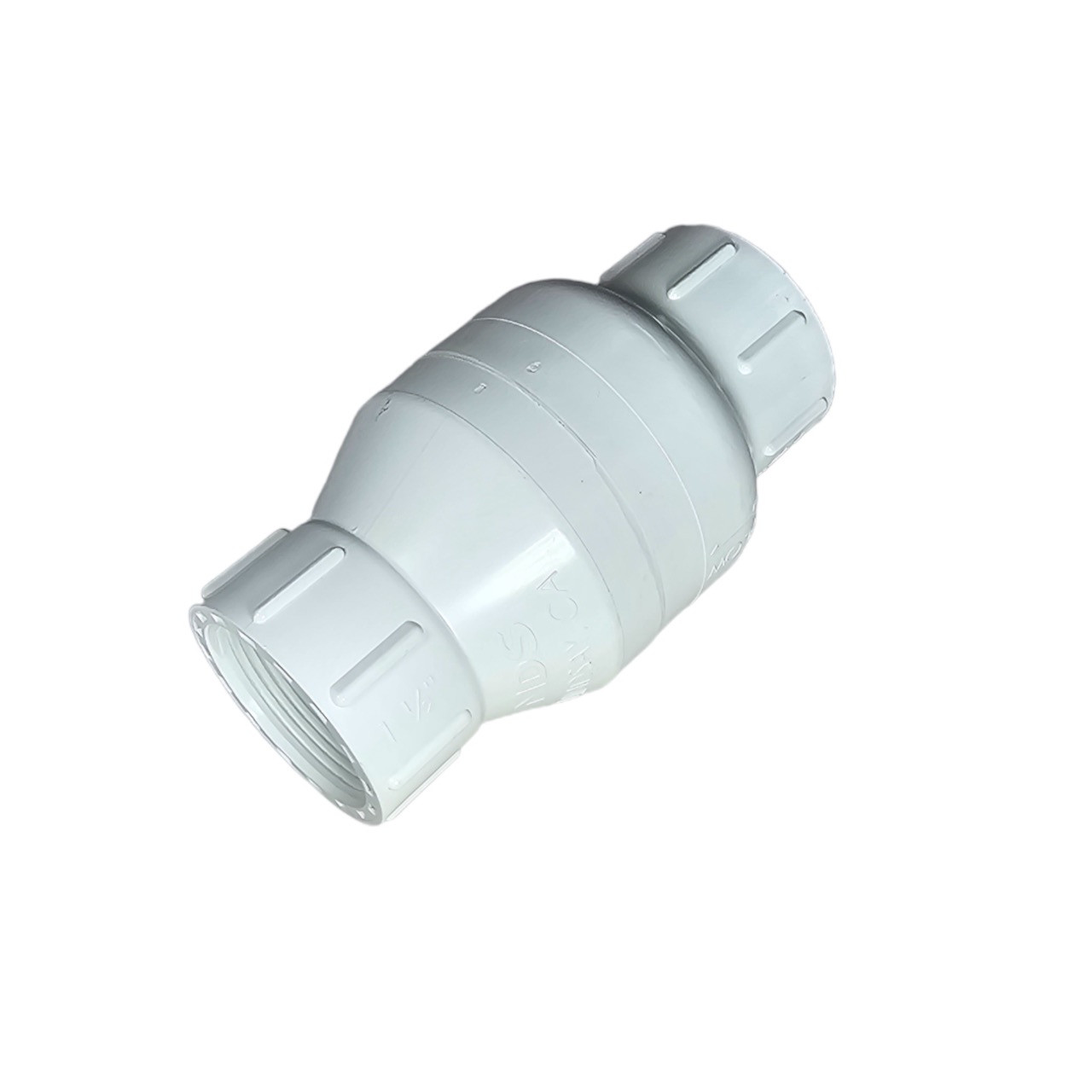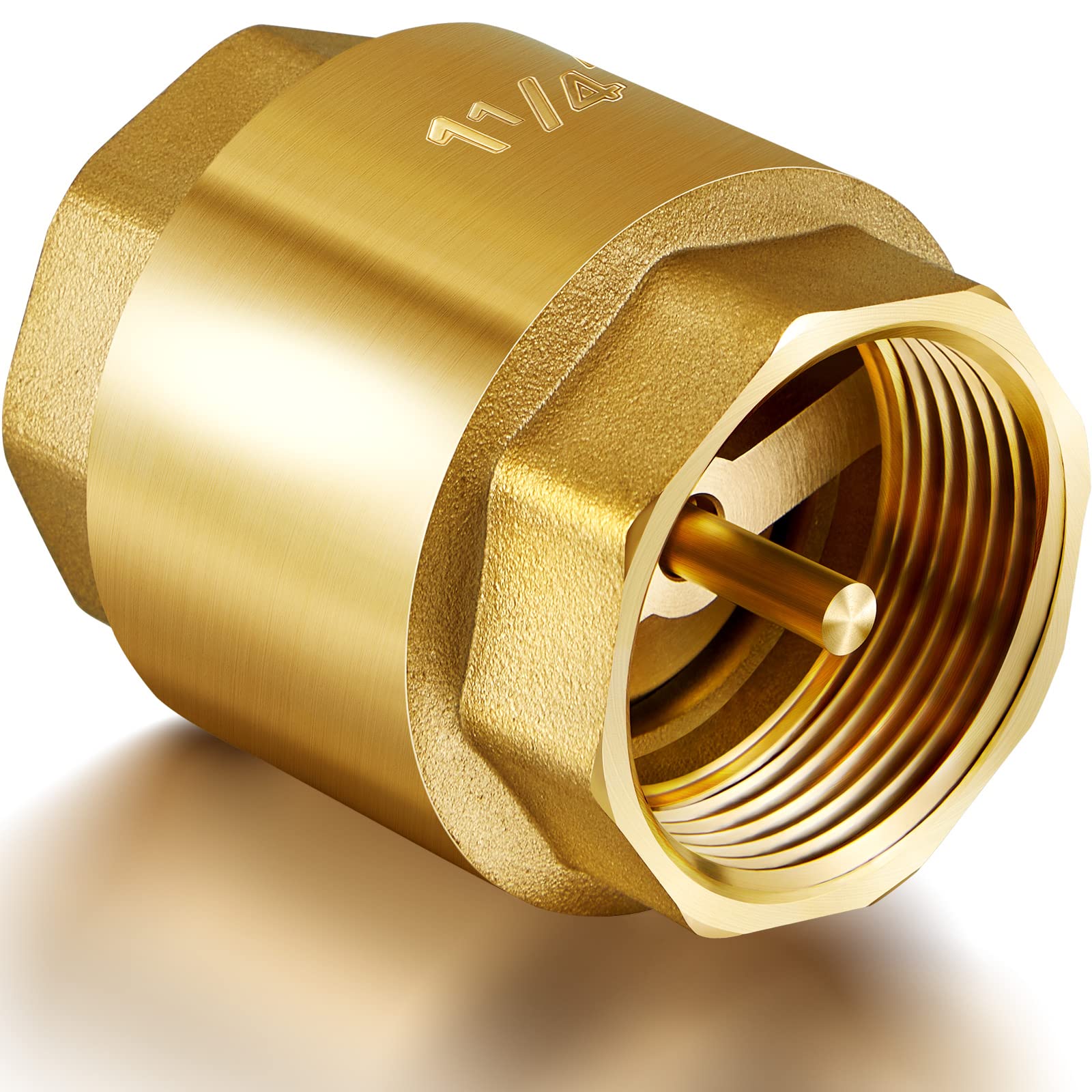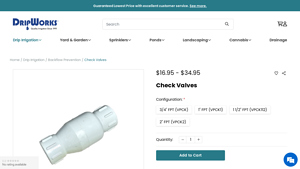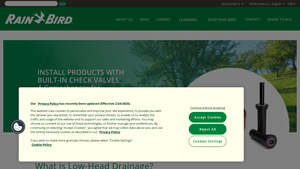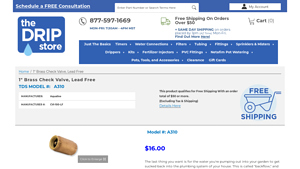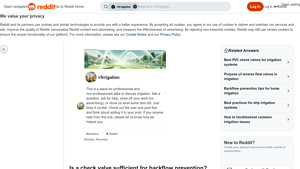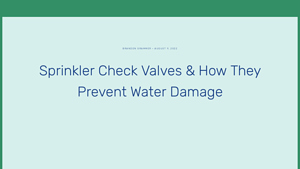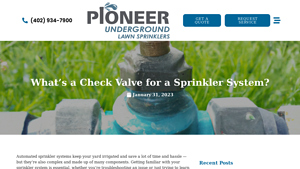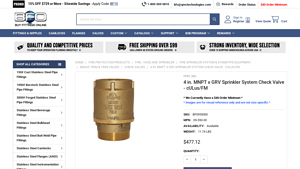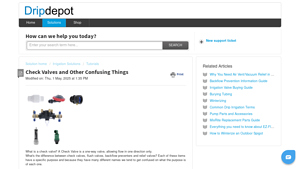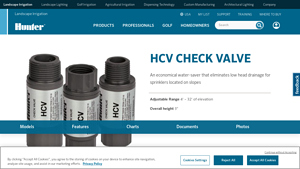Introduction: Navigating the Global Market for check valve for irrigation system
The global market for check valves in irrigation systems presents a unique challenge for international B2B buyers, particularly in regions such as Africa, South America, the Middle East, and Europe. As agricultural demands rise and water conservation becomes imperative, sourcing reliable check valves is essential for maintaining efficient irrigation practices. These critical components prevent backflow and low-head drainage, safeguarding investments in irrigation systems while promoting sustainable water management.
This comprehensive guide delves into various types of check valves, their specific applications in different irrigation setups, and critical factors for supplier vetting. It also addresses cost considerations, enabling buyers to make informed financial decisions. Whether you are a seasoned agricultural supplier or an emerging buyer in the irrigation sector, understanding the nuances of check valve technology can significantly enhance your operational efficiency and product reliability.
By providing actionable insights and a thorough analysis of the market, this guide empowers international B2B buyers to navigate the complexities of sourcing check valves for irrigation systems. With a focus on quality, performance, and compliance with regional standards, you will be equipped to select the right products that meet your needs and contribute to sustainable agricultural practices. Embrace the opportunity to enhance your irrigation systems with the right check valves and ensure a resilient future for your agricultural endeavors.
Understanding check valve for irrigation system Types and Variations
| Type Name | Key Distinguishing Features | Primary B2B Applications | Brief Pros & Cons for Buyers |
|---|---|---|---|
| Inline Check Valves | Installed within the pipeline, allowing unidirectional flow | Drip and sprinkler irrigation systems | Pros: Easy installation; compact design. Cons: May require more maintenance than other types. |
| Foot Valves | Located at the water source, prevents backflow | Pump systems, wells, and reservoirs | Pros: Maintains pump prime; prevents water loss. Cons: Limited to specific applications. |
| Anti-Siphon Valves | Prevents backflow and contamination, often with built-in checks | Residential and commercial irrigation setups | Pros: Protects water supply; reduces risk of contamination. Cons: More expensive than standard valves. |
| Spring-Loaded Check Valves | Utilizes a spring mechanism to close under low pressure | High-elevation irrigation systems | Pros: Effective in varied pressure conditions; reliable. Cons: Can wear out over time; may need replacements. |
| Built-in Check Valves | Integrated into irrigation products, providing dual function | Landscape irrigation systems | Pros: Space-saving; reduces installation complexity. Cons: Limited to specific products; less flexibility. |
What Are Inline Check Valves and When Should They Be Used?
Inline check valves are designed to be installed directly within the irrigation pipeline. They allow water to flow in one direction and automatically shut off when pressure decreases, preventing backflow. These valves are particularly beneficial in drip and sprinkler irrigation systems where space is limited. When considering B2B purchases, buyers should evaluate the ease of installation and the potential need for regular maintenance, which can impact overall operational efficiency.
How Do Foot Valves Function in Irrigation Systems?
Foot valves are essential components typically installed at the water source, such as wells or ponds. They prevent backflow when the pump is turned off, ensuring that the pump remains primed for the next use. Foot valves are ideal for businesses that rely on pump systems for irrigation. Buyers should consider their durability and resistance to corrosion, as these factors significantly affect their lifespan and maintenance costs.
What Are the Benefits of Anti-Siphon Valves in Irrigation?
Anti-siphon valves are specifically designed to prevent backflow and protect the water supply from contamination. These valves are often used in residential and commercial irrigation setups, where safeguarding potable water is crucial. When purchasing, B2B buyers should weigh the higher initial costs against the long-term benefits of enhanced water quality and compliance with local regulations.
Why Choose Spring-Loaded Check Valves for High-Elevation Systems?
Spring-loaded check valves utilize a spring mechanism to maintain closure under low pressure conditions, making them suitable for high-elevation irrigation systems. Their ability to function effectively despite pressure fluctuations is a key advantage. Buyers should be aware that while these valves are reliable, they may require periodic replacements due to wear and tear, which can affect long-term costs.
How Do Built-in Check Valves Enhance Irrigation Systems?
Built-in check valves are integrated into various irrigation products, such as drip lines and spray heads. This design not only saves space but also simplifies installation processes. They are particularly advantageous for landscape irrigation systems where efficiency is paramount. B2B buyers should evaluate the compatibility of these valves with existing systems, as their integration can limit flexibility in future modifications.
Key Industrial Applications of check valve for irrigation system
| Industry/Sector | Specific Application of Check Valve for Irrigation System | Value/Benefit for the Business | Key Sourcing Considerations for this Application |
|---|---|---|---|
| Agriculture | Used in drip and sprinkler irrigation systems to prevent backflow. | Ensures efficient water usage, reducing waste and enhancing crop yield. | Look for durable materials, resistance to corrosion, and compliance with local regulations. |
| Landscape Design & Maintenance | Integrated in residential and commercial landscaping systems. | Prevents overwatering and erosion, promoting sustainable landscaping. | Consider ease of installation and compatibility with existing systems. |
| Golf Course Management | Installed in irrigation systems to maintain optimal turf health. | Reduces water waste and enhances the playability of the course. | Prioritize valves with high hold-back capacities and durability against frequent use. |
| Municipal Water Management | Utilized in public parks and recreational areas for irrigation. | Supports water conservation efforts and complies with municipal codes. | Ensure compliance with local water authority standards and regulations. |
| Greenhouse Operations | Used to manage water flow in hydroponic systems. | Optimizes water delivery, improving plant growth and resource efficiency. | Evaluate valve reliability under varying pressure conditions and ensure ease of maintenance. |
How is Check Valve for Irrigation Systems Used in Agriculture?
In the agricultural sector, check valves are critical components in both drip and sprinkler irrigation systems. They prevent backflow, ensuring that water flows in one direction and does not contaminate the water supply. This is particularly vital in regions with varying topographies, where gravity can cause drainage issues. By maintaining consistent water pressure, check valves help farmers optimize water usage, which is essential for enhancing crop yields and conserving resources in water-scarce areas like parts of Africa and South America.
What Role do Check Valves Play in Landscape Design & Maintenance?
In landscape design and maintenance, check valves are integrated into irrigation systems to prevent overwatering and soil erosion. They are especially useful in residential and commercial landscapes where uneven terrain may lead to water pooling and plant damage. For international buyers, sourcing check valves that are easy to install and compatible with existing systems is crucial. This contributes to sustainable landscaping practices, aligning with environmental regulations in regions like Europe and the Middle East.
Why are Check Valves Important for Golf Course Management?
Golf courses utilize check valves in their irrigation systems to maintain turf health and playability. These valves help prevent water waste by ensuring that water does not drain back into the system when not in use. For golf course managers, selecting valves with high hold-back capacities is essential, especially in regions with significant elevation changes. This choice not only conserves water but also enhances the overall quality of the course, making it more appealing to players.
How do Municipal Water Management Systems Benefit from Check Valves?
Municipal water management systems employ check valves in the irrigation of public parks and recreational areas. These valves support water conservation initiatives by preventing unnecessary water loss and ensuring compliance with local regulations. For municipal buyers, it is vital to source check valves that meet specific local water authority standards. This not only aids in sustainable management practices but also enhances the aesthetic and functional value of public spaces.
What is the Application of Check Valves in Greenhouse Operations?
In greenhouse operations, check valves are essential for managing water flow in hydroponic systems. They optimize the delivery of water to plants, ensuring that resources are used efficiently. For international buyers, it is important to evaluate the reliability of check valves under varying pressure conditions, as well as their ease of maintenance. By ensuring a consistent water supply, these valves contribute to improved plant growth and operational efficiency in a controlled environment.
3 Common User Pain Points for ‘check valve for irrigation system’ & Their Solutions
Scenario 1: Issues with Low-Head Drainage in Sloped Landscapes
The Problem: B2B buyers managing irrigation systems in regions with varying elevations often encounter significant challenges due to low-head drainage. When the system is turned off, gravity causes water to flow back down, leading to puddling at the lowest points. This not only wastes water but can also lead to soil erosion, uneven watering, and damage to landscaping. For buyers in regions like Africa or South America, where water conservation is critical, this issue can be particularly frustrating and costly.
The Solution: To address low-head drainage effectively, it is essential to incorporate high-quality check valves into the irrigation design. Sourcing check valves with robust hold-back capabilities—ideally those that can retain water pressure equivalent to at least 10-14 feet of elevation—will help prevent backflow. Buyers should evaluate products that are specifically designed for sloped terrains and ensure they are installed at the lowest points in the system. Regular maintenance and checks are also vital; inspect these valves for wear and tear to guarantee they function correctly. This proactive approach not only conserves water but also enhances the overall efficiency of the irrigation system.
Scenario 2: Backflow Contamination Risks
The Problem: In many regions, particularly in the Middle East and parts of Europe, the risk of backflow contamination poses a serious threat to irrigation systems. If a sudden drop in pressure occurs, contaminated water can flow back into the main supply, jeopardizing the quality of the irrigation water and, by extension, the crops or plants being nourished. This issue is especially critical in agricultural B2B environments where the quality of water directly affects yield and profitability.
The Solution: To mitigate backflow risks, it is crucial to implement a dual approach: using both check valves and backflow preventers. While check valves can prevent water from draining back down the system, they do not offer complete protection against contamination. Buyers should invest in check valves that are compatible with backflow prevention devices and ensure they are compliant with local regulations. Educating staff on the importance of regularly testing and maintaining these devices will further enhance water quality and safety. By prioritizing water integrity, businesses can protect their investments and ensure the health of their agricultural products.
Scenario 3: Frequent Equipment Damage from Water Hammer
The Problem: A common yet often overlooked issue in irrigation systems is water hammer, a phenomenon that occurs due to sudden changes in water flow, often resulting in pressure spikes. This is particularly problematic for B2B buyers operating in Europe and the Middle East, where high-quality irrigation equipment is essential for maintaining efficiency. Frequent water hammer can lead to premature wear on pumps and valves, causing expensive downtime and repairs.
The Solution: To combat water hammer, buyers should consider installing check valves designed to minimize pressure fluctuations. Look for products that include features such as cushioning or dampening to absorb shock waves created by sudden flow changes. It is also advisable to incorporate surge tanks or air chambers in the system design to further mitigate these effects. Regularly monitoring system pressure and conducting maintenance checks on valves and other components will help identify potential issues before they escalate. By proactively addressing water hammer, companies can extend the lifespan of their equipment, reduce repair costs, and enhance overall system reliability.
Strategic Material Selection Guide for check valve for irrigation system
What are the Key Materials for Check Valves in Irrigation Systems?
When selecting check valves for irrigation systems, the choice of material is crucial for ensuring optimal performance, longevity, and compatibility with various environmental conditions. Below, we analyze four common materials used in the manufacturing of check valves, focusing on their properties, advantages, disadvantages, and considerations for international B2B buyers.
How Does Brass Perform as a Material for Check Valves?
Brass is a popular choice for check valves due to its excellent corrosion resistance and durability. It typically withstands high temperatures and pressures, making it suitable for various irrigation applications. Brass check valves can handle media with a pH range of 6 to 8, which is ideal for most irrigation water sources.
Pros: Brass check valves are robust and have a long lifespan, often exceeding 10 years with proper maintenance. They are also relatively easy to manufacture and can be produced in various sizes.
Cons: The primary drawback of brass is its cost, which tends to be higher than plastic alternatives. Additionally, brass can corrode if exposed to aggressive chemicals or extreme pH levels outside its tolerance.
Impact on Application: Brass is compatible with a wide range of irrigation media but may not be suitable for highly acidic or alkaline environments.
Considerations for International Buyers: Compliance with standards such as ASTM and DIN is crucial. Buyers in Europe, for instance, often prefer lead-free brass due to stricter regulations regarding drinking water safety.
What Advantages Does PVC Offer for Check Valves?
PVC (Polyvinyl Chloride) is a lightweight and cost-effective material commonly used in irrigation systems. It has good chemical resistance and can handle a moderate range of temperatures and pressures.
Pros: PVC check valves are affordable and easy to install, making them a popular choice for budget-conscious projects. They are resistant to corrosion, which extends their lifespan in many applications.
Cons: PVC has a lower temperature and pressure rating compared to metals like brass. It can become brittle over time, especially when exposed to UV light or extreme temperatures.
Impact on Application: PVC is suitable for non-potable water applications and is often used in drip irrigation systems. However, it should not be used in high-pressure situations.
Considerations for International Buyers: Buyers should ensure that PVC products meet local building codes and standards, as regulations can vary significantly across regions, particularly in Europe and South America.
How Does Stainless Steel Compare for Check Valve Applications?
Stainless steel is renowned for its strength and resistance to corrosion, making it an excellent choice for check valves in harsh environments. It can withstand high temperatures and pressures, making it suitable for a variety of irrigation systems.
Pros: The durability of stainless steel check valves often results in a longer lifespan compared to other materials. They are also resistant to rust and can handle a wide range of media, including saline water.
Cons: The main disadvantage is the higher cost associated with stainless steel, which can be a barrier for some projects. Additionally, manufacturing stainless steel components can be more complex, leading to longer lead times.
Impact on Application: Stainless steel is ideal for applications involving aggressive media or extreme conditions, such as coastal areas with saline water.
Considerations for International Buyers: Compliance with international standards such as JIS and ASTM is essential. Buyers should also consider the availability of stainless steel options in their region, as supply chains may vary.
What Role Does Plastic Play in Check Valve Manufacturing?
Plastic check valves, often made from materials like polypropylene or polyethylene, are lightweight and resistant to corrosion. They are commonly used in irrigation systems where chemical exposure is a concern.
Pros: Plastic check valves are generally the most affordable option and are easy to install. They are resistant to a wide range of chemicals, making them suitable for various irrigation applications.
Cons: The primary limitation of plastic is its lower strength and durability compared to metal options. They may not perform well under high-pressure conditions.
Impact on Application: Plastic is ideal for low-pressure applications and is commonly used in residential irrigation systems.
Considerations for International Buyers: Buyers should verify that plastic check valves meet local standards and regulations, as different regions may have specific requirements regarding material safety and environmental impact.
Summary Table of Material Selection for Check Valves
| Material | Typical Use Case for Check Valve for Irrigation System | Key Advantage | Key Disadvantage/Limitation | Relative Cost (Low/Med/High) |
|---|---|---|---|---|
| Brass | General irrigation systems, especially in urban areas | Excellent durability and corrosion resistance | Higher cost, sensitive to extreme pH levels | High |
| PVC | Drip irrigation systems, non-potable applications | Cost-effective and easy to install | Lower temperature/pressure rating | Low |
| Stainless Steel | Harsh environments, saline water applications | High strength and corrosion resistance | Higher cost, complex manufacturing | High |
| Plastic | Residential irrigation systems, low-pressure applications | Lightweight and chemical resistant | Lower strength and durability | Low |
This strategic material selection guide provides essential insights for B2B buyers in the irrigation sector, facilitating informed decisions that align with their specific operational needs and regional regulations.
In-depth Look: Manufacturing Processes and Quality Assurance for check valve for irrigation system
What Are the Main Stages in the Manufacturing Process of Check Valves for Irrigation Systems?
The manufacturing process of check valves for irrigation systems involves several critical stages, ensuring that the final product meets the high standards required for reliable performance. The main stages include material preparation, forming, assembly, and finishing.
Material Preparation
The selection of materials is paramount in the manufacturing of check valves. Common materials include brass, stainless steel, and high-grade plastics, each chosen for their durability and resistance to corrosion. The preparation phase involves cutting raw materials into specified dimensions, which may include machining processes such as turning and milling to achieve precise tolerances.
Forming
Forming techniques vary depending on the material and design of the check valve. For metal check valves, processes such as forging or casting are commonly employed to shape the body of the valve. Plastics may undergo injection molding, where heated plastic is injected into a mold to create the desired shape. This stage is critical for ensuring that the valve components align correctly and function effectively within the irrigation system.
Assembly
Once the individual components are formed, they are assembled into a complete valve. This stage may involve the integration of various parts, including springs, seals, and body components. Automated assembly lines are often used to enhance efficiency, although manual assembly may be employed for more intricate designs. Ensuring that each component is fitted accurately is essential to prevent leaks and ensure proper operation.
Finishing
The finishing stage involves surface treatments and coatings that enhance the valve’s resistance to environmental factors. Processes such as polishing, anodizing, or applying protective coatings can significantly improve durability and aesthetic appeal. This stage may also include quality checks to verify that the valve meets dimensional and functional specifications.
How Is Quality Assurance Implemented in the Manufacturing of Check Valves?
Quality assurance (QA) is a critical aspect of the manufacturing process, ensuring that each check valve meets international standards and customer expectations. The QA process typically adheres to international standards such as ISO 9001, as well as industry-specific certifications like CE and API.
International Standards Compliance
ISO 9001 provides a framework for quality management systems, focusing on consistent product quality and customer satisfaction. Manufacturers must document their processes and continuously improve them to maintain certification. This international recognition is vital for B2B buyers, as it assures them of the manufacturer’s commitment to quality.
Industry-Specific Certifications
Beyond ISO standards, check valves may require additional certifications based on their application. For example, the CE mark indicates compliance with European safety and environmental standards, while API certifications are crucial for valves used in oil and gas applications. Understanding these certifications is essential for buyers in different regions, as it may affect regulatory compliance.
What Are the Key Quality Control Checkpoints in Check Valve Manufacturing?
Quality control (QC) checkpoints are strategically placed throughout the manufacturing process to ensure that each valve meets the necessary specifications.
Incoming Quality Control (IQC)
The IQC stage involves the inspection of raw materials before they enter the production line. This initial assessment verifies that materials meet predefined standards for quality and composition. Any materials that do not meet specifications are rejected and replaced.
In-Process Quality Control (IPQC)
During the manufacturing process, IPQC is implemented to monitor production activities. This includes regular inspections at various stages, such as after forming and assembly, to ensure that each component meets quality standards. Statistical process control (SPC) techniques may be used to track performance and identify any deviations from quality norms.
Final Quality Control (FQC)
The FQC stage involves a comprehensive assessment of the finished check valves. This includes functional testing to ensure that the valves operate correctly under expected conditions, as well as dimensional checks to verify compliance with specifications. Any valves that do not pass this stage are reworked or discarded.
What Common Testing Methods Are Used to Ensure Check Valve Quality?
Testing methods for check valves vary based on their design and application but generally include several common techniques.
Hydraulic Testing
Hydraulic testing is crucial for assessing a valve’s ability to withstand pressure without leaking. This test involves subjecting the valve to water or oil at specified pressure levels to ensure that it can maintain integrity under operating conditions.
Functional Testing
Functional tests simulate real-world conditions to verify that the valve operates as intended. This includes checking for backflow prevention, ensuring that the valve opens and closes correctly, and assessing the response to pressure changes.
Durability Testing
Durability tests are conducted to evaluate the longevity of the valve under continuous use. This may involve cycling the valve through multiple open and close operations to assess wear over time.
How Can B2B Buyers Verify Supplier Quality Control Processes?
For B2B buyers, verifying a supplier’s quality control processes is essential to ensure reliable product performance. Here are several strategies to accomplish this.
Supplier Audits
Conducting supplier audits allows buyers to assess the manufacturer’s quality management systems firsthand. These audits can evaluate compliance with international standards, examine production processes, and review documentation related to quality assurance.
Quality Control Reports
Requesting quality control reports provides insights into the supplier’s testing methods and results. These reports should detail the outcomes of IQC, IPQC, and FQC processes, along with any corrective actions taken in response to identified issues.
Third-Party Inspections
Engaging third-party inspection services can offer an unbiased evaluation of a supplier’s quality control practices. These inspections can be arranged at various stages of production, providing buyers with an additional layer of assurance regarding product quality.
What Are the Quality Control Nuances for International B2B Buyers?
International B2B buyers, particularly from regions like Africa, South America, the Middle East, and Europe, face unique challenges in ensuring quality control.
Understanding Regional Standards
Buyers must familiarize themselves with local regulations and standards that may differ from international norms. For instance, certain countries may have specific requirements for certification that impact product acceptance.
Cultural Differences in Quality Expectations
Cultural attitudes towards quality and compliance can vary significantly across regions. Buyers should consider these differences when negotiating contracts and setting quality expectations with suppliers.
Logistical Considerations
International shipping can introduce additional complexities, such as potential damage during transit. Buyers should ensure that suppliers employ robust packaging and handling processes to mitigate these risks.
By understanding the manufacturing processes, quality assurance protocols, and verification methods, B2B buyers can make informed decisions when sourcing check valves for irrigation systems. These insights can lead to more successful partnerships and ultimately contribute to the efficiency and sustainability of irrigation projects.
Practical Sourcing Guide: A Step-by-Step Checklist for ‘check valve for irrigation system’
Introduction
This practical sourcing guide aims to assist B2B buyers in procuring check valves for irrigation systems effectively. Check valves are vital components that prevent backflow and ensure optimal water management, particularly in regions with varying topography. By following this checklist, buyers can make informed decisions that enhance irrigation efficiency and sustainability.
Step 1: Define Your Technical Specifications
Establishing clear technical specifications is crucial before initiating the procurement process. Consider factors such as the type of irrigation system in use (e.g., drip, sprinkler), the required pressure ratings, and the materials needed for the valves, such as brass or plastic. These specifications will help narrow down options and ensure compatibility with existing systems.
Step 2: Assess the Environmental Conditions
Understanding the environmental conditions where the check valves will be installed is essential. Consider factors such as soil type, water quality, and potential exposure to corrosive elements. This assessment will guide you in selecting valves that are durable and suited for specific climates, ultimately prolonging their lifespan and reducing maintenance costs.
Step 3: Evaluate Potential Suppliers
Before committing, it is crucial to vet suppliers thoroughly. Request company profiles, case studies, and references from buyers in similar industries or regions. Pay attention to their experience in the irrigation sector and their ability to meet your specific technical requirements. Reliable suppliers often provide warranties and post-sale support, which can be valuable.
Step 4: Review Certifications and Compliance
Ensure that the check valves meet local and international standards for quality and safety. Certifications such as ISO, NSF, or local building codes should be verified to guarantee that the products will perform reliably and safely. Compliance with these standards can also prevent costly legal issues in the future.
Step 5: Compare Pricing and Payment Terms
Obtain quotes from multiple suppliers to compare pricing structures. While cost is an important factor, consider the overall value, which includes product quality, warranty, and customer service. Additionally, review payment terms and delivery schedules to ensure they align with your project timelines and budget constraints.
Step 6: Ask About Maintenance and Support Services
Inquire about the maintenance requirements and support services offered by the supplier. A reputable supplier should provide guidance on installation, routine maintenance, and troubleshooting. Understanding these aspects can help you avoid unexpected downtime and costly repairs in the future.
Step 7: Make a Decision and Confirm Order Details
After evaluating all factors, make your decision based on a comprehensive analysis of your findings. Confirm order details, including quantities, delivery timelines, and any special requirements. Clear communication with the supplier at this stage will help avoid misunderstandings and ensure a smooth procurement process.
By following this structured checklist, B2B buyers can navigate the complexities of sourcing check valves for irrigation systems, ultimately leading to more efficient and sustainable irrigation practices.
Comprehensive Cost and Pricing Analysis for check valve for irrigation system Sourcing
What Are the Key Cost Components for Sourcing Check Valves for Irrigation Systems?
When sourcing check valves for irrigation systems, understanding the cost structure is vital for effective budgeting and procurement. The primary cost components include:
Materials: The choice of materials significantly influences the price. Common materials include brass, stainless steel, and plastic. Brass check valves, for example, tend to be more expensive due to their durability and corrosion resistance, while plastic options may offer lower upfront costs but could require more frequent replacements.
Labor: Labor costs encompass the expenses associated with manufacturing, assembly, and quality control. Labor rates can vary significantly by region, impacting the overall cost, especially for international buyers.
Manufacturing Overhead: This includes costs related to utilities, maintenance, and factory management. Efficient manufacturing processes can help reduce these overhead costs, leading to lower prices for buyers.
Tooling: Initial tooling costs can be high, especially for custom or specialized check valves. These costs are often amortized over the production run, meaning larger orders can benefit from lower per-unit costs.
Quality Control (QC): Ensuring that check valves meet industry standards and certifications can add to costs. However, investing in quality control can prevent costly failures and maintenance in the long run.
Logistics: Shipping and handling costs are crucial, especially for international transactions. Factors such as distance, shipping method, and customs duties can significantly affect the total cost.
Margin: Suppliers will add a profit margin to cover their business expenses and desired profit. Understanding typical margins in your industry can help in negotiations.
How Do Price Influencers Impact Check Valve Procurement?
Several factors influence the pricing of check valves that buyers should consider:
Volume/MOQ (Minimum Order Quantity): Larger orders typically lead to better pricing due to economies of scale. Establishing a long-term relationship with suppliers can also facilitate better terms and pricing.
Specifications and Customization: Custom designs or specific specifications can increase costs. Buyers should weigh the benefits of customization against potential price increases.
Materials and Quality Certifications: Valves made from higher-quality materials or those that meet specific certifications will often come at a premium. Buyers should assess the trade-off between cost and long-term durability.
Supplier Factors: The reputation and reliability of suppliers can influence pricing. Established suppliers may charge more due to their proven track record, while newer companies may offer competitive pricing to build their market presence.
Incoterms: Understanding Incoterms is crucial for international buyers. Terms like FOB (Free on Board) or CIF (Cost, Insurance, and Freight) can affect total costs by determining who pays for shipping and insurance.
What Are Effective Buyer Tips for Cost-Efficient Sourcing?
International buyers, particularly from regions such as Africa, South America, the Middle East, and Europe, should consider the following strategies for cost-efficient sourcing of check valves:
Negotiation: Engage in open negotiations with suppliers. Being transparent about your budget and volume needs can lead to favorable terms.
Total Cost of Ownership (TCO): Consider the long-term costs associated with the product, including maintenance, replacement, and operational efficiency. A cheaper initial purchase price may not always equate to lower overall costs.
Pricing Nuances: Be aware of regional pricing differences. For instance, European suppliers may have higher manufacturing costs due to labor laws and regulations, while suppliers in South America may offer competitive pricing due to lower overhead.
Quality Assurance: Prioritize quality over price to minimize future costs related to failures or inefficiencies. Investing in reliable check valves can lead to significant savings in maintenance and water conservation.
Disclaimer on Indicative Prices
While indicative prices for check valves typically range from $16.95 to $34.95 based on specifications and materials, actual costs may vary based on the factors outlined above. Buyers are encouraged to obtain quotes from multiple suppliers to ensure competitive pricing tailored to their specific needs.
Alternatives Analysis: Comparing check valve for irrigation system With Other Solutions
Introduction: Exploring Alternatives to Check Valves for Irrigation Systems
In the realm of irrigation systems, ensuring optimal water flow and preventing backflow are critical for efficiency and sustainability. While check valves are a popular choice for these purposes, various alternatives exist that can also address similar challenges. This analysis will compare check valves with two viable alternatives: foot valves and backflow preventers. Each option has unique features that cater to different irrigation needs, making it essential for B2B buyers to assess their specific requirements before making a decision.
Comparison Table
| Comparison Aspect | Check Valve For Irrigation System | Foot Valve | Backflow Preventer |
|---|---|---|---|
| Performance | Prevents backflow, retains water in pipes | Maintains water in pump systems, prevents backflow | Stops contaminated water from entering the supply |
| Cost | Moderate, varies by brand and features | Generally lower, depending on material | Higher due to complexity and regulations |
| Ease of Implementation | Relatively easy, requires placement at low points | Simple installation, often near water sources | May require professional installation to meet codes |
| Maintenance | Low maintenance, occasional checks needed | Moderate, requires inspection for debris | Regular maintenance necessary to ensure functionality |
| Best Use Case | Slopes and uneven terrains to prevent drainage | Pump systems and water sources | Systems requiring protection against contamination |
Detailed Breakdown of Alternatives
Foot Valves: When Are They the Best Choice?
Foot valves serve a similar purpose to check valves but are primarily used in pump systems. They allow water to flow into the pump while preventing backflow when the pump is off. This makes them ideal for applications where maintaining water levels is critical, such as in wells or ponds. Foot valves are generally more cost-effective than check valves, but they can require more frequent maintenance due to sediment and debris accumulation. Their installation is straightforward, but they must be positioned correctly to function effectively.
Backflow Preventers: Ensuring Water Safety
Backflow preventers are essential in systems where there’s a risk of contaminated water entering the main supply. Unlike check valves, which prevent backflow only in irrigation applications, backflow preventers are designed to protect drinking water and must meet stringent local codes. Their complexity often requires professional installation, making them a more expensive option. However, they provide robust protection against contamination, making them indispensable for systems connected to potable water sources.
Conclusion: Making the Right Choice for Your Irrigation Needs
When selecting the right solution for irrigation systems, B2B buyers must consider several factors, including performance, cost, ease of implementation, and specific application needs. Check valves are ideal for preventing drainage in sloped terrains, while foot valves excel in maintaining water levels in pump systems. Backflow preventers, though more expensive and complex, are critical for safeguarding drinking water. By understanding these alternatives, buyers can make informed decisions that align with their operational requirements and ensure the longevity and efficiency of their irrigation systems.
Essential Technical Properties and Trade Terminology for check valve for irrigation system
What Are the Key Technical Properties of Check Valves for Irrigation Systems?
When selecting check valves for irrigation systems, several technical specifications are crucial for ensuring optimal performance and longevity. Below are some critical properties to consider:
Material Composition
Check valves are commonly made from materials such as brass, PVC, and stainless steel. Brass and stainless steel are known for their durability and resistance to corrosion, making them ideal for long-term use in irrigation systems. PVC is lightweight and cost-effective but may not withstand high pressures as effectively. Understanding the material composition helps in assessing durability and compatibility with various water types, especially in regions with varying water qualities.Pressure Rating
The pressure rating indicates the maximum pressure the valve can handle without failing. Typical pressure ratings range from 150 psi to 300 psi. Choosing a valve with an appropriate pressure rating is essential for preventing leaks and ensuring system integrity, particularly in high-pressure irrigation systems.Flow Rate
Flow rate, often measured in gallons per minute (GPM), determines how much water can pass through the valve in a given time frame. This is vital for ensuring that the irrigation system delivers adequate water to plants. A valve with a too-low flow rate can lead to inadequate watering, while one with too high may waste resources.Hold-Back Capacity
This property refers to the valve’s ability to prevent backflow and hold water at varying elevations. Check valves with a high hold-back capacity are essential in systems with significant elevation changes to prevent low-head drainage, which can waste water and damage the landscape.Size and Compatibility
Check valves come in various sizes, typically ranging from ½ inch to 3 inches in diameter. Selecting the right size is crucial for ensuring compatibility with existing piping and maintaining optimal flow rates. Proper sizing also reduces the risk of leaks and pressure loss in the system.Installation Type
Check valves can be installed inline or as part of a larger assembly. The installation type affects how the valve integrates with the irrigation system and its overall efficiency. Understanding the installation requirements is key for professionals to ensure proper setup and maintenance.
Which Trade Terminology Should B2B Buyers Know Regarding Check Valves?
Understanding industry terminology is essential for effective communication and decision-making in B2B transactions. Here are some common terms related to check valves:
OEM (Original Equipment Manufacturer)
An OEM refers to a company that produces parts or equipment that may be marketed by another manufacturer. In the context of check valves, buyers may seek OEM products for better compatibility and reliability within their irrigation systems.MOQ (Minimum Order Quantity)
MOQ is the smallest quantity of a product that a supplier is willing to sell. For check valves, understanding MOQ is crucial for B2B buyers to plan their purchases effectively, particularly when sourcing from international suppliers.RFQ (Request for Quotation)
An RFQ is a document sent to suppliers to solicit a price for specific goods or services. B2B buyers often use RFQs to compare prices, lead times, and terms from multiple suppliers, ensuring they make informed purchasing decisions.Incoterms (International Commercial Terms)
Incoterms are a set of predefined commercial terms published by the International Chamber of Commerce (ICC) that clarify the responsibilities of buyers and sellers in international transactions. Familiarity with Incoterms is vital for B2B buyers to understand shipping costs, risks, and delivery obligations when importing check valves from global suppliers.Lead Time
Lead time refers to the amount of time it takes from placing an order to receiving the goods. For irrigation systems, knowing the lead time for check valve delivery is crucial for project planning and ensuring timely installation.Backflow Prevention
This term describes measures taken to prevent contaminated water from flowing back into the main supply. While check valves help minimize backflow, understanding the distinction between check valves and dedicated backflow preventers is important for maintaining water quality in irrigation systems.
By grasping these technical properties and trade terminologies, B2B buyers can make more informed decisions when sourcing check valves for irrigation systems, ultimately leading to more efficient and sustainable operations.
Navigating Market Dynamics and Sourcing Trends in the check valve for irrigation system Sector
What Are the Global Drivers and Key Trends Influencing the Check Valve for Irrigation Systems Market?
The check valve market for irrigation systems is experiencing robust growth driven by several global factors. Firstly, increasing agricultural demands due to a growing global population necessitate efficient water management solutions. This urgency is particularly pronounced in regions like Africa and South America, where agricultural productivity is vital for economic stability. Additionally, advancements in technology, including smart irrigation systems that integrate check valves, are enhancing efficiency and reducing water waste. The trend toward automation in agriculture is leading to a higher demand for innovative irrigation solutions that incorporate check valves to prevent backflow and low-head drainage, thus ensuring optimal performance.
Moreover, international B2B buyers are increasingly focused on sourcing products that comply with local regulations and sustainability standards. In Europe, for instance, there is a strong push towards environmentally friendly practices, which is influencing purchasing decisions. Countries like Germany are leading the way in sustainable agricultural technology, making it imperative for suppliers to offer products that align with these values. Emerging markets in the Middle East are also investing in irrigation technologies, creating opportunities for B2B transactions that prioritize efficiency and sustainability.
How Is Sustainability and Ethical Sourcing Reshaping the Check Valve for Irrigation Systems Market?
Sustainability is becoming a cornerstone of procurement strategies in the check valve market. The environmental impact of irrigation systems is under scrutiny, prompting buyers to seek solutions that minimize waste and conserve water. Check valves play a crucial role in this regard by preventing backflow and controlling drainage, thereby reducing erosion and preserving soil integrity.
Furthermore, ethical sourcing practices are gaining traction among B2B buyers. Companies are increasingly interested in suppliers who demonstrate transparency in their supply chains and adhere to fair labor practices. Certifications such as ISO 14001 for environmental management and other green certifications are becoming prerequisites for suppliers aiming to operate in markets like Europe and North America. Buyers are also leaning towards lead-free materials and products that contribute to overall water quality, ensuring that their sourcing decisions align with both environmental and health standards.
What Is the Historical Context of Check Valves in Irrigation Systems?
The use of check valves in irrigation systems has evolved significantly over the past few decades. Initially designed to prevent backflow in simple irrigation setups, advancements in materials and technology have transformed check valves into sophisticated components integral to modern irrigation systems. Early versions were primarily made from brass and other metals, but with the advent of plastic and composite materials, today’s check valves are more durable and resistant to corrosion.
Historically, the focus was primarily on functionality; however, with increasing awareness of environmental issues, the modern era emphasizes efficiency and sustainability. Innovations such as built-in check valves in drip irrigation systems are now common, allowing for enhanced water conservation and better management of resources. This evolution reflects a broader trend in the irrigation industry towards integrating technology that not only supports agricultural productivity but also aligns with sustainable practices.
In summary, understanding the dynamics of the check valve market, along with the importance of sustainability and the historical context of these products, is essential for international B2B buyers looking to make informed purchasing decisions in a rapidly evolving landscape.
Frequently Asked Questions (FAQs) for B2B Buyers of check valve for irrigation system
How do I solve low-head drainage issues in my irrigation system?
To address low-head drainage, which occurs when water flows downhill after the system shuts off, installing check valves is essential. These valves prevent backflow, ensuring water remains in the irrigation lines, thus maintaining pressure and preventing unnecessary waste. Check valves should be strategically placed at the lowest points in your system to maximize effectiveness. Regular maintenance and inspection will ensure they function properly and can significantly enhance the sustainability of your irrigation setup.What is the best type of check valve for irrigation systems?
The best check valve for your irrigation system depends on several factors, including the specific application, water pressure, and elevation changes. Inline spring check valves are often recommended for their reliability and ability to handle pressure fluctuations. If your system experiences significant height differences, consider valves with high hold-back capabilities to prevent low-head drainage effectively. Always consult with suppliers about product specifications to ensure compatibility with your irrigation design.How can I verify the quality of check valves from suppliers?
To verify the quality of check valves, request certifications and product specifications from potential suppliers. Look for valves made from durable materials such as brass or stainless steel, which resist corrosion and ensure longevity. Checking customer reviews and seeking references from previous clients can also provide insights into a supplier’s reliability. Additionally, inquire about warranty terms and the supplier’s quality assurance processes to confirm their commitment to product excellence.What are the typical minimum order quantities (MOQs) for check valves?
Minimum order quantities (MOQs) for check valves can vary widely between suppliers, often ranging from 50 to 500 units depending on the manufacturer and the type of valve. Some suppliers may offer flexibility for smaller orders, particularly if you are testing products before committing to larger purchases. Always discuss your specific needs with suppliers to negotiate terms that align with your business requirements and budget constraints.What payment terms should I expect when sourcing check valves internationally?
Payment terms for international purchases of check valves typically include options like advance payment, letters of credit, or payment upon delivery, depending on the supplier’s policies and your business relationship. Many suppliers may require a deposit upfront, with the balance due upon shipment or delivery. It’s essential to clarify these terms in advance and consider using secure payment methods to protect your investment, especially when dealing with new suppliers.How do I handle logistics and shipping for check valves sourced internationally?
Handling logistics for international shipping of check valves involves selecting a reliable freight forwarder familiar with customs regulations in your country. Discuss shipping methods, costs, and delivery timelines with your supplier to avoid unexpected delays. Ensure that all necessary documentation, such as commercial invoices and packing lists, is prepared to facilitate smooth customs clearance. It may also be beneficial to explore insurance options to protect your shipment during transit.Are there specific regulations for check valves in irrigation systems that I should be aware of?
Yes, various countries have specific regulations and standards regarding irrigation equipment, including check valves. For instance, in the European Union, products must comply with CE marking requirements, while in the United States, they must meet ANSI standards. When sourcing internationally, research local regulations to ensure compliance and avoid potential issues with installation or operation. Consulting with local experts or industry associations can provide valuable insights into these requirements.Can I customize check valves to fit my irrigation system’s needs?
Many suppliers offer customization options for check valves, allowing you to tailor specifications such as size, material, and pressure ratings to suit your irrigation system. Customization can enhance performance and compatibility with existing infrastructure. Discuss your specific needs with suppliers to determine available options and any associated costs or lead times. Being clear about your requirements upfront can lead to better outcomes and more efficient irrigation solutions.
Important Disclaimer & Terms of Use
⚠️ Important Disclaimer
The information provided in this guide, including content regarding manufacturers, technical specifications, and market analysis, is for informational and educational purposes only. It does not constitute professional procurement advice, financial advice, or legal advice.
While we have made every effort to ensure the accuracy and timeliness of the information, we are not responsible for any errors, omissions, or outdated information. Market conditions, company details, and technical standards are subject to change.
B2B buyers must conduct their own independent and thorough due diligence before making any purchasing decisions. This includes contacting suppliers directly, verifying certifications, requesting samples, and seeking professional consultation. The risk of relying on any information in this guide is borne solely by the reader.
Top 9 Check Valve For Irrigation System Manufacturers & Suppliers List
1. DripWorks – One-Way Check Valves
Domain: dripworks.com
Registered: 1998 (27 years)
Introduction: Check Valves – Price Range: $16.95 – $34.95. SKU: Q_VPCK. Description: One-way check valves prevent water from flowing back into the home water supply during sudden pressure loss. They can be installed on downward slopes to prevent water from draining back and are commonly used in pump systems to eliminate back pressure. Specifications: 1/2 pound internal spring, available with pipe threads (FPT x…
2. Rain Bird – Seal-A-Matic™ Check Valve
Domain: rainbird.com
Registered: 1995 (30 years)
Introduction: Rain Bird offers check valves that prevent low-head drainage, conserving water and minimizing erosion. Their check valves can hold back 8 to 14 feet of water, with specific products like the XFS-CV dripline providing 10 feet of hold-back. Key products include the Seal-A-Matic™ Check Valve, which holds back up to 14 feet, and various spray heads and rotors with built-in check valves ranging from 7 …
3. Drip Irrigation – 1 Brass Check Valve
Domain: dripirrigation.com
Registered: 1997 (28 years)
Introduction: 1″ Brass Check Valve for Irrigation Systems, Lead Free, Model # A310, SKU: CVI-100-LF, Regular Price: $16.00, Heavy-duty brass construction suitable for high-pressure environments, designed to prevent backflow in irrigation systems, complies with ASTM and ANSI codes, features a 1/2-pound spring for a positive seal with no back pressure, not compatible with garden hose or spigot without adapters.
4. Reddit – Affordable 3/4 PVC Check Valves
Domain: reddit.com
Registered: 2005 (20 years)
Introduction: 3/4″ PVC check valves for sale for <$10; intended for use in drip irrigation systems to prevent backflow into the home.
5. Commercial Lawn Irrigation – Sprinkler Check Valves
Domain: commerciallawnirrigation.com
Registered: 2009 (16 years)
Introduction: Sprinkler check valves prevent excess water from leaking out of sprinkler systems, conserving water and reducing potential water damage. They work by automatically opening and closing a disc based on water pressure, ensuring water flows in one direction. Pre-installed check valves are recommended for efficient operation, while post-installation may be necessary for some systems. Benefits include p…
6. Pioneer Underground – Check Valves
Domain: pioneerunderground.net
Registered: 2010 (15 years)
Introduction: Check valves are critical components in sprinkler systems that regulate water flow, prevent backflow, and protect potable water supplies. They are located between the sprinkler head and the water supply, allowing water to flow in one direction while blocking reverse flow. Key benefits include backflow prevention, improved efficiency, adjustable control for water output, and increased system longev…
7. Buy Fittings Online – Sprinkler System Check Valves
Domain: buyfittingsonline.com
Registered: 1999 (26 years)
Introduction: Sprinkler System Check Valves – 4″ MNPT x GRV
8. Drip Depot – Check and Flush Valves
Domain: help.dripdepot.com
Registered: 2005 (20 years)
Introduction: Check Valves: One-way valves allowing flow in one direction, used in irrigation to protect equipment from backflow damage, stop low head drainage, prevent contamination, and provide pressure relief. Inline check valves are common in positive pressure systems. Flush Valves: Used at the ends of irrigation lines for quick flushing at startup to remove debris. Auto Drain Valves are similar for sprinkl…
9. Hunter – HCV Check Valve
Domain: hunterirrigation.com
Registered: 2001 (24 years)
Introduction: HCV Check Valve is an economical water-saver that eliminates low head drainage for sprinklers located on slopes. It has an adjustable range of 4′ – 32′ of elevation and an overall height of 3 inches. The product line includes various models: HC-50F-50F (½” female inlet x ½” female outlet), HC-50F-50M (½” female inlet x ½” male outlet), and HC-75F-75M (¾” female inlet x ¾” male outlet). Key benefit…
Strategic Sourcing Conclusion and Outlook for check valve for irrigation system
In conclusion, strategic sourcing of check valves for irrigation systems is vital for optimizing water management and ensuring sustainable agricultural practices. By investing in high-quality check valves, buyers can prevent low-head drainage, reduce water waste, and minimize erosion, ultimately leading to significant cost savings and enhanced system performance. The variety of options available—including inline spring valves and lead-free alternatives—allows for tailored solutions that meet specific regional needs.
For international buyers, particularly those in Africa, South America, the Middle East, and Europe, it’s crucial to partner with reputable suppliers who provide durable and efficient products that comply with local regulations. Understanding the performance specifications of check valves, such as their hold-back capacity, can further empower decision-making in irrigation system design.
As we look to the future, the demand for sustainable irrigation solutions will only grow. Now is the time to reassess your sourcing strategies and incorporate advanced check valve technologies into your irrigation systems. Embrace the opportunity to enhance your operations and contribute to global water conservation efforts. Connect with trusted suppliers today to explore the best options for your irrigation needs.

